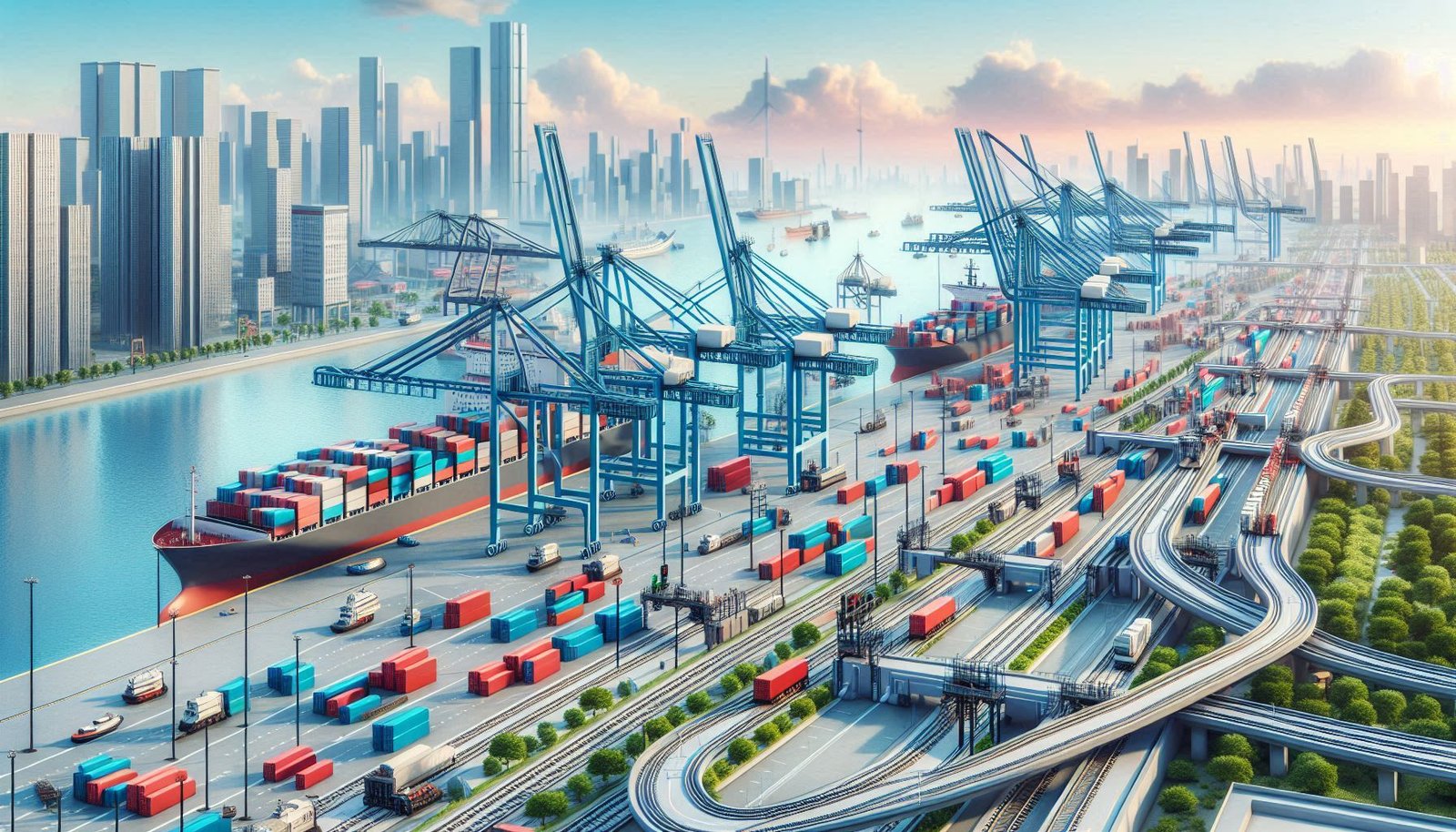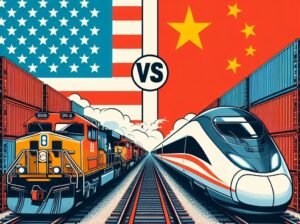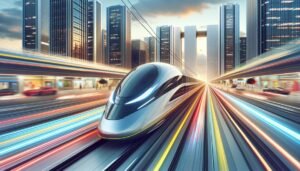by Marcos Kleber R Felix
What if Brazil’s railway system transported more than 30% of the goods circulating in the country, instead of the current 15%? What if more than a third of the cargo transported by trains in Brazil were general goods, rather than just 8% as it is now? How would the Brazilian economy look if the country’s railways could play a leading role in national logistics? Could we implement door-to-door rail transport?
This text aims to explore the possibility of fostering a door-to-door railway network in Brazilian logistics, following Law No. 14,273 of 2021, which could revolutionize national logistics by reducing costs, increasing efficiency, and promoting sustainability. In the context of Brazilian railways, this would mean a necessary and urgent transformation in the way goods are transported, potentially boosting the country’s economy and competitiveness.
This text also addresses the initiatives for the implementation of new railways by two Brazilian giants in logistics and pulp production, respectively, Rumo and Eldorado.
Scarcity of Railway Infrastructure in Brazil
Door-to-door is a logistics concept attributed to road transport. It means that products can be transported from the origin (factories, mines, or farms) directly to the destination (final consumer) without the need for transfers between vehicles or intermediate warehouses. The closest we have to this in Brazilian railways is the mine-railway-port concept, where iron ore is transported directly from the mines of the iron quadrangle in Minas Gerais or Carajás in Pará, by railways, to port terminals, all under the management of a single company.
As we know, logistics in Brazil heavily depends on truck transport. What we often do not realize is that this transport occurs on a sparse road network. According to the National Confederation of Transport, in 2019, the paved road network in Brazil was approximately 212 thousand km. Thus, the road density in Brazil in 2019 was only 25 m/km². This value is 17 times lower than that of the USA, which has a paved road network of over 4.3 million kilometers. Obviously, more roads mean more origins and destinations, shorter travel times, greater possibilities for logistical arrangements, lower costs, and higher productivity.
In the railway mode, this comparison is even worse for Brazil. According to the Federal Government, Brazilian railways transport approximately 15% of national production. Meanwhile, American railways transport about 40%. The Brazilian railway density is officially 3.1 m/km² – in reality, this number is much worse, about 2 m/km², if we discount the abandoned tracks from the equation – the American railway density is 150 m/km², i.e., 48 times higher than the Brazilian.
Does the USA have the largest economy in the world because it has a dense and widespread transport infrastructure, or does it have a dense and widespread infrastructure because it has a robust economy? The obvious answer is that there is no developed economy without abundant transport infrastructure.
The scarcity of Brazilian transport infrastructure signals one of the reasons why Brazilian productivity and competitiveness in the international and domestic scenario are so criticized. Still, despite such poor logistical infrastructure, Brazil plays a prominent role in the production and export of certain commodities, including pulp. In recent decades, Bracell, Eldorado, and Suzano, among other companies, have helped catapult Brazil to the top position in pulp exports, with an annual production of about 23 million tons, leaving the USA, Canada, and China behind in the export ranking.
Brazilian Challenges of Shifting Logistics from Highways to Railways
As suggested by the introduction of this text, our pulp logistics heavily relies on road transport, which is extremely costly and environmentally unfriendly compared to our global competitors. However, in recent years, we have seen significant efforts by Brazilian pulp plants to shift their logistics from highways to railways.
The three largest pulp industries in the country already transport part of their production by train through the ports of São Luís and Santos to some extent. But starting in 2021, when the new railway legislation came into effect, these companies began a process of integrating railways into their logistics strategies. They requested authorization to build new railways from their plants directly to the current granted network, which could, in the future, enable “door-to-door” transport from their manufacturing plants to export ports, creating new factory-railway-port corridors.
The most advanced case is Eldorado, located in Três Lagoas, Mato Grosso do Sul. Currently, 100% of Eldorado’s export production in Três Lagoas involves some form of road transit to four different ports: Santos in São Paulo, Paranaguá in Paraná, Itapoã, and Navegantes in Santa Catarina.
In 2019, Eldorado acquired the rights to build and operate a dedicated port terminal at the Port of Santos. This terminal, with a capacity of 3 million tons per year, was designed to be supplied by trucks and trains of up to 72 wagons. In 2021, the company requested the construction of a new railway line of about 90 km between its plant in Três Lagoas and the Rumo network in Aparecida do Taboado.
The construction of this new railway could represent a shift of more than 60% of Eldorado’s production to the railway mode, creating a direct link between the factory and the port, not only reducing costs but also improving the company’s productivity.
With the expansion of the plant from the current 1.8 million to 4.5 million tons annually, about 30,000 trucks would be taken off the roads, representing a reduction in CO2 emissions of 120,000 tons annually.
The shift of 60% of Eldorado’s production from road to rail could cost around R$ 1.8 billion in capex, about 7.5% of the cost of implementing its new manufacturing plant, according to publicly available information. This would be a relatively low cost compared to the economic gains from decommissioning the truck fleet, diesel consumption, and eligibility for green financing due to the implementation of a more sustainable logistics solution.
Additionally, Eldorado positions itself with this initiative for other economic advantages with the implementation of the new railway line, whether in increasing business opportunities with Rumo, the incumbent of the main line to Santos; the possibility of composition in the Internal Railway of the Port of Santos (FIPS); and even sharing its private line to Três Lagoas for use by other companies in the region. The new Eldorado line could also be used for grain transport in the region, both for export and for the domestic market, in the provision of fertilizers and corn to the South of the country.
Obviously, the implementation of a new logistics solution requires several stages, such as environmental authorizations, expropriations, both already guaranteed in their initial phases; price negotiations with other railways; articulations with government agents; engineering project elaborations; acquisition of rolling stock; hiring specialized labor, etc. Therefore, the project needs time to come to fruition.
This project, however, deserves to be celebrated and encouraged, both for its positive externalities and for its educational value to the rest of the Brazilian industry, which is highly dependent on road logistics. Eldorado’s railway is the most advanced case of a federally authorized railway coming to fruition, but it cannot and should not be the only one.
When we look at the data from the National Land Transport Agency (ANTT), we see that 72% of the railway extension requested from the Union, in new projects by authorization, is in the process of obtaining a preliminary license, but only Eldorado has obtained the required license. The slowness in obtaining the preliminary license in the vast majority of requested cases may indicate that the environmental licensing processes for railways need to be improved. The railway mode is notably more sustainable than the road mode. Moreover, Brazil needs both green investments and an adjustment of its transport matrix to comply with the more sustainable competitiveness dictates of the 21st century.
For example, we can infer that if only 10% of the requested and already contracted projects at the federal level are actually completed, 1,254 km of new tracks could be added to the scarce national railway network. A 10% success rate would also represent private investments of around R$ 24 billion, according to ANTT data. This would provide fundamental relief to public accounts, which are currently facing yet another fiscal setback. Not to mention the potential generation of over 100,000 direct jobs, new businesses, productivity, and profitability, as well as a reduction in fossil fuel consumption, pollutant emissions, road accident losses, social expenses, etc.
However, this is a very conservative estimate compared to the oldest and most advanced authorized railway project in the country: the Senador Vicente Emílio Vuolo State Railway, which will connect the municipalities of Rondonópolis, Lucas do Rio Verde, and Cuiabá in the state of Mato Grosso, being executed by Rumo.
The state authorization project of the logistics giant Rumo, which holds the rights to operate five federal railway concessions, foresees the construction of 730 kilometers of tracks and an investment of R$ 11.2 billion. The physical progress of the Vicente Vuolo Railway by Rumo is even more robust than Eldorado’s, as it has already obtained not only the environmental licenses but has also started the construction of the railway in its first 100 km from Rondonópolis towards Lucas do Rio Verde.
Benefits of the New Railway Legislation and Future Prospects
The new railway legislation has provided Brazil with a unique opportunity for cooperation between the public and private sectors to reduce logistical bottlenecks. The success of Eldorado and Rumo represents the first steps, but they cannot be the only ones. The Brazilian industry, not just in cellulose and grain exports or commodity production, must, along with federal and state governments, realize that the implementation of new tracks is essential for increasing Brazilian productivity, economic recovery, and societal satisfaction.
Evidently, the implementation of a new public policy entirely based on private investment, in a scenario where most highways were or are being implemented, directly or indirectly, with public resources, will not be a process free of necessary learnings and adjustments. In this context, the question arises as to which financing models, provided by public banks, may be suitable to foster these ventures, and to what extent public entities could be legitimized to assist in the bureaucratic and regulatory procedures that such entrepreneurs inevitably face.
Furthermore, it raises the reflection on how tax legislation could contribute to correcting the current imbalance in the transportation matrix, which is predominantly road-based. Although significant progress is observed, it is undeniable that there is still vast room for improvements, aiming at the establishment of a more attractive and secure business environment for the private sector.
More efficient coordination could allow more and more industries to benefit from flexible railway projects, made on demand, to suppress logistical bottlenecks, increase capacity and productivity, with direct effects on the national economy and indirect effects on the lives of all Brazilians. For this, regulatory and tariff impasses must be addressed more diligently by regulatory authorities, so that Brazil can indeed get on the tracks of the 21st century. Railways have always helped Brazil; it is time for Brazil to understand that it needs to help the railways to develop as a nation.
Although it is obvious that there will be a significant mortality rate in authorizations, whether due to the difficulty of raising funds in the project finance model, the impediment in obtaining environmental licenses or expropriations, or even the institutional limitations of the country to quickly converge to the application of best regulatory practices that ensure competitive infrastructure sharing tariffs and prevent uneconomic practices by economic agents, the fact is that the success of authorized railways represents a quality logistical increase for the national economy, as exemplified by the successful cases of Eldorado in Mato Grosso do Sul and Rumo in Mato Grosso.
Final Considerations
Encouraging market initiatives in building a new and distributed national railway network, so vast that it could enable door-to-door rail transport, represents a unique opportunity for Brazil to modernize its transportation infrastructure and boost economic development. By reducing logistical costs, companies could invest more in innovation and expansion, generating jobs and strengthening the national economy. Additionally, the reduction in pollutant gas emissions would contribute to a more sustainable future, aligning the country with global environmental preservation goals.
For this vision to become a reality, it is essential that the government and companies work together in the effective application of the advancements brought by Law No. 14,273 of 2021, improving public policies that encourage investment in railway infrastructure. Implementing new tracks in Brazil requires not only financial resources but also a change in mindset and the adoption of new technologies that make transportation more efficient and safe. With a joint effort, Brazil can transform its transportation system and reach a new level of sustainable development.


